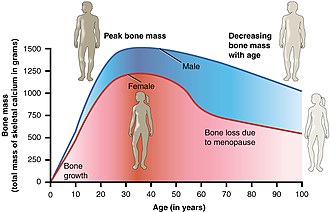Physiology of aging
Aging of an organism is a physiological event ending in the death of an individual. During aging, there is a reduction of bodily functions, or a decrease in the functional capacity of the organism – adaptability and resistance to mental and physical stress decreases. We are primarily prevented from reaching old age by diseases to which we are more susceptible as we age.
Life expectancy is to some extent genetically determined.
Aging of the Nervous System[edit | edit source]
In the past, the prevailing theory was that nerve cells decrease with increasing age. Current findings, however, have shown that the speed of this decline is not at all as fast as was assumed. The rapid loss of neurons is caused by pathological conditions, eg Alzheimer's disease. Important for nerve activity is not only the number of cells, but also their interconnection and 'myelination of their projections, and this is the reason for the significant improvement of memory at school age.
In old age, the number of dendrites gradually decreases and so does the interconnection of cells. Recall and memory deteriorate, but certain trends can be observed in this process. Information acquired from an early age is retained in the memory until old age. From this it can be concluded that the neuronal circuits created at a later age disappear first.
Aging of the nervous system also affects the body's motor skills, in this respect we observe the opposite effect to that of memory. Overall, movements are slowed down and large movements, such as walking, are more demanding. The motor skills of fine movements, which a person acquires relatively later in life, remain preserved.
Aging of the musculoskeletal system[edit | edit source]
We can talk about multiple processes:
- increase in body fat and loss of skeletal muscle mass,
- degeneration of joint cartilages, arthrosis (growth of bone growths),
- change in bone structure – osteoporosis.
The result is a decrease in muscle strength (senile sarcopenia). The organism has its maximum strength in the third decade, in the fourth to fifth decade it decreases by about 10%, in the sixth to seventh decade by another 15% and from the eighth decade on average by 30%.
Ageing Transportation System[edit | edit source]
Several changes occur in the respiratory and vascular system:
- destruction of the septa in the alveoli, resulting in senile emphysema,
- deterioration of chest resistance,
- reduction of blood oxygen saturation,
- loss of compliance of the vascular wall, elastic fibers are replaced by collagen and thus blood pressure increases.
Hypoxia leads to less use of oxidative phosphorylation in favor of anaerobic glycolysis and this results in poorer endurance even with less physical load. Insulin sensitivity gradually decreases and glucose metabolism changes, often leading to diabetes.
Heart disease is one of the most common problems in people over the age of 65. Blood lipids (such as cholesterol) increase in the blood and this can lead to other complications such as myocardial infarction.
Causes of Aging[edit | edit source]
The causes of aging still remain a mystery, but there are several theories:
- biological clock theory (genetic program of the cell),
- theory of the influence of the external environment,
- error theory (affects DNA),
- senile pigment theory (mainly in long-lived cells that do not have enzymes to process lipofuscin),
- theory free radicals.
An unstable genome can lead to accelerated aging. Chromosomes are more and more damaged during life, because 'telomeres at their ends, which protect chromosomes from negative influences, shorten.
A low-calorie diet at a younger age may increase lifespan by reducing fasting plasma cholesterol concentrations and preventing visceral fat deposition.
Links[edit | edit source]
Related Articles[edit | edit source]
References[edit | edit source]
- KITTNAR, Otomar et al. Grada Publishing 2011. p.757 - 760., 1st edition, Prague, ISBN 978-80-247-3068-4.
- SILBERNAGL, Stefan and DESPOPOULOS, Agamemnon, Grada Publishing 2016. pp. 44-45, translation of the 8th German edition, Prague, ISBN 978-80-247-4271-7.

